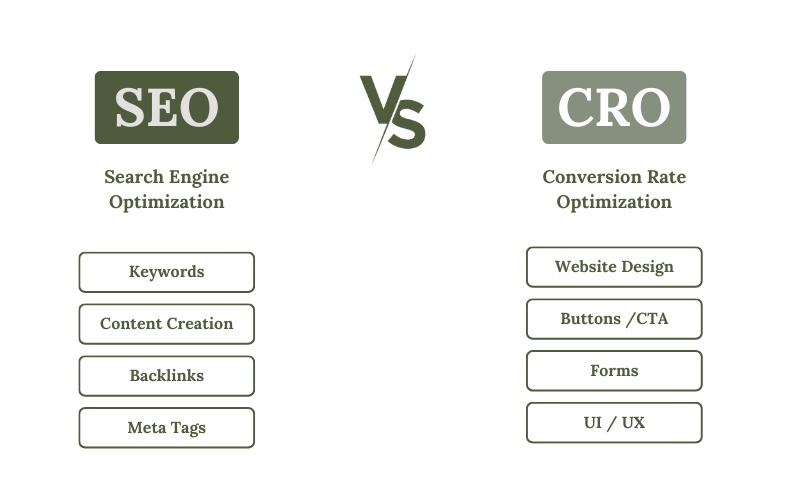SEO and CRO: Are They Related?
SEO and conversion rate optimization (CRO) may seem like they’re playing in different sandboxes, but truth be told, they’re more like dynamic duos. Let’s break it down:
SEO, the superhero of boosting website visibility, swoops in with its bag of tricks to amp up organic traffic. Think of it as the guardian angel of search engine rankings.
On the flip side, CRO steps onto the scene, decked out in its optimization armor, aiming to turn those visitors into action-takers. It’s all about tweaking your site to make sure folks are hitting that “add to cart” button or filling out those forms like nobody’s business.
Now, here’s where the magic happens: when these two join forces, it’s like unlocking a superpower for your website. SEO does its thing, focusing on keywords and meta tags to climb those search engine ranks. Meanwhile, CRO takes the reins on user engagement elements, like crafting irresistible calls to action (CTAs) and fine-tuning submission forms.
The result? A powerhouse combo that not only gets your site noticed but also turns those eyeballs into conversions. It’s the ultimate tag team for fueling your business growth.

Basic of CRO: Maximizing Conversions
here’s the lowdown on conversion rate optimization (CRO): It’s all about boosting that conversion rate, which is basically the percentage of folks who do what you want them to on your website.
Now, the math behind it isn’t too complicated. Here’s the nifty formula to calculate CRO: Conversion Rate (%) = Total number of conversions / Total number of visitors * 100.
To work its magic, CRO dives deep into how people behave on your website. We’re talking clicks, scroll depth, you name it. Then, it’s all about tweaking your site’s elements to nudge more users into taking the actions you’re after.
Now, these actions can be as diverse as your favorite playlist. Think submitting a form, snagging a product, setting up a meeting, you get the idea. Different pages might have different goals too.
For instance, on a product page, your aim might be to get folks to pop something in their shopping cart. On a blog post, maybe it’s all about scoring more email subscribers.
The key to upping those conversion rates? Crystal-clear goals for each page. Once you’ve got those down, it’s time to whip out your CRO toolbox and start spicing things up to reel in more of those desired actions.
Nine Ways To Combine CRO
Make sure your SEO and CRO efforts have each other’s backs by blending them together.
Align both SEO and CRO Goals
Syncing up your SEO and CRO objectives in your marketing game plan is a smart move if you’re aiming to boost both your organic traffic and conversion rates.
Imagine you ditched a meeting-booking widget on one of your pages because it was dragging down the load time. Sure, it might give your SEO a pat on the back by speeding up the page, but chances are, it’s taking a toll on your conversion rate.
That’s why having a joint discussion about your SEO and conversion rate optimization strategies is crucial.
Think about throwing these questions into the mix when you’re in the brainstorming phase:
- Where does your organic website visitor stand in your marketing funnel?
- What’s the most likely action they’ll take to convert?
- Does your page content nudge them in that direction?
- Could tweaking the design push them to take that action?
- Will messing with the design affect how well your page performs in search results?
Addressing these questions head-on can steer you clear of clashes between your SEO and CRO efforts. Plus, it sets the stage for merging both strategies into one seamless marketing approach.
Optimize For Keyword Search Intent
When you search for something online, there’s a reason behind it, right? That’s what we call search intent. It’s like getting into the mind of the searcher to understand what they’re really after when they type in a keyword.
Now, there are basically four types of search intent:
- Navigational: This is when someone’s just trying to find a specific website or page.
- Informational: Here, people are looking for answers or info on a particular topic.
- Commercial: This is when someone’s checking out products or services but might not be ready to buy yet.
- Transactional: And finally, this is when someone’s all set to make a purchase or take action.
Now, why does this matter for Conversion Rate Optimization (CRO)? Well, think about it. If you know what people are really searching for, you can tailor your website to guide them towards taking action—like making a purchase or booking a service.
Imagine you run a Marketing Agency, and you’re aiming to get more bookings through your website. If someone Googles “marketing agency in Chicago” they’re probably just browsing, not necessarily ready to book a room for Fluffy yet.
But if they search for “marketing agency near me,” they’re likely closer to making a decision. They might even be ready to book a spot for their furry friend.
So, when you optimize your website for search engines (that’s the SEO part), focusing on keywords with transactional intent can actually boost your chances of getting more bookings. See, it’s not just about driving traffic; it’s about driving the right kind of traffic—people who are ready to convert.
By knowing how to tweak your content for both SEO and CRO, you can make sure your website isn’t just attracting visitors but turning them into paying customers or clients. And that’s where the real magic happens!
Creat High-Quality SEO Friendly Content
When it comes to boosting your website’s performance, quality content development is your best ally. Why? Well, think of it like this: top-notch content stands a much better chance of snagging a prime spot in those coveted search engine results pages (SERPs). And you know what that means? More eyes on your site, which equals more chances to turn those visitors into conversions.
But here’s the kicker: even if you manage to lure in those organic visitors, if your content doesn’t hit the mark in terms of relevance or usefulness, they might just bounce right back to the SERPs without batting an eye. And guess what? That’s a conversion opportunity down the drain.
So, what’s the secret sauce to creating this high-quality content that keeps both the search engines and your potential customers happy? Google’s got some pointers:
- Whip up some original content that’s packed with fresh info, research, or insights.
- Dive deep into your topic and leave no stone unturned.
- Give your readers some food for thought with insightful analysis that goes beyond the obvious.
- Make sure your content delivers real value that stands out from the competition in those SERPs.
- Oh, and don’t forget to dot your i’s and cross your t’s – steer clear of those pesky typos and grammar slip-ups.
Remember, when it comes to SEO and CRO, quality content is the name of the game. So, roll up your sleeves and start crafting content that’s sure to make both Google and your audience sit up and take notice!
Focus on Title Tags and Meta Descriptions
When you nail your title tags and meta descriptions, you’re not just playing the SEO game—you’re winning over potential customers too.
Think about it: Your title tag, that clickable blue line you see in search results? It’s like your webpage’s first impression. And the meta description? It’s the enticing snippet that says, “Hey, click me! I’ve got what you need.”
Take, for instance, our hypothetical marketing agency in Chicago. Their title tag and meta description? Total champs at SEO and conversion rate optimization (CRO).

The meta description? It’s packed with SEO-friendly keywords like “marketing agency in Chicago,” but it goes beyond that. It’s got that little nudge, “Let’s Talk,” urging users to take action.
So, how do you craft these little nuggets of gold? Here are some top tips:
- Tune in to what users are searching for and tailor your tags and descriptions accordingly.
- Stick to the SEO-friendly character limits: around 50 to 60 for title tags and about 105 for meta descriptions.
- Sprinkle in those keywords or their variations, but keep it natural.
- Make it irresistible—tell users why they should click with a promise of value or relevance.
- Sweeten the deal with extras like discounts or promotions (“Free Shipping,” anyone?).
By fine-tuning your title tags and meta descriptions with these tricks, you’ll not only boost your search visibility but also reel in those clicks and conversions like a pro.
Use CTAs
Let’s chat about calls to action (CTAs)! They’re those nifty bits of text that nudge visitors into taking action on a website. You’ve probably seen them around, like “Book Today,” “Call us,” or “Learn more.” Each one serves up a different flavor of action, depending on what the visitor’s after.
For instance, if someone’s ready to book a reservation, they’ll click “Book Today.” If they’re more in the mood for a chat to get some info, they’ll hit up “Chat Now!” or “Let’s Talk!” It’s all about catering to their search vibe.
Now, when it comes to beefing up your conversion rate optimization (CRO), CTAs are like the secret sauce. Tweaking the text, where you slap it on the page, and even the color can make a big difference in getting folks to take the plunge.
Here’s a few CRO ninja moves to soup up your CTAs:
- Size Matters: Make sure your text is big enough to read without squinting. Nobody likes playing Where’s Waldo with tiny buttons.
- Power Words: Action-packed verbs like “Book,” “Call,” or “Subscribe” give your CTAs that extra oomph.
- Pop with Color: Pick a color that jumps off the page and screams, “Click me!” High contrast is your friend here.
- Keyword Magic: Slip in relevant keywords or variations if they fit naturally. It’s like giving your CTA an SEO boost while you’re at it.
- Top of the Heap: Stick your CTAs above the fold, so they’re front and center when visitors land on your page. No hunting required.
- Jazz it Up: Add some pizzazz with interactive elements. Make buttons change color or grow a size when hovered over. It’s like digital confetti.
So, next time you’re fine-tuning your website, remember: killer CTAs are the cherry on top of your CRO sundae.
Harness The Power Of Testimonials and Social Proof
You know, reviews and testimonials pack a serious punch when it comes to both boosting your SEO and leveling up your conversion rate optimization (CRO).
Think about it—before hitting that “buy now” button, most folks out there are scouring through customer reviews. They’re like the modern-day word-of-mouth, signaling trustworthiness, which, by the way, Google loves as a marker of top-notch content.
So, if you’ve got some glowing reviews or heartwarming testimonials tucked away, don’t keep them to yourself! Sprinkle them across your website like confetti at a celebration.
For local businesses, it’s all about urging customers to drop those golden reviews on third-party platforms. The more stars you rack up there, the shinier your local listing becomes.
And for those in the B2B game, testimonials aren’t just pats on the back—they’re showcases of customer satisfaction and what makes your offering stand out in the crowd.
Here’s the kicker: you can turbocharge your review game even more by:
- Slipping in some review schema markup onto your webpages
- Setting up a dedicated “Reviews” page on your site
- Sneaking customer testimonials into the header or footer for that extra oomph
- Dropping reviews strategically into your content like little nuggets of wisdom
Remember, the more thumbs-up you collect, the more firepower you’ve got for your SEO and CRO maneuvers. But hey, as the review train picks up speed, you’ll want to make sure you’ve got a handle on things.
That’s where the Review Management tool swoops in like a caped crusader, helping you keep tabs on those online reviews and maintain your reputation. From reading and replying to analyzing, it’s your one-stop-shop for review superheroics.
Try A/B Testing
Ever heard of A/B testing? It’s like putting two versions of a webpage in a virtual boxing ring to see which one comes out on top. Here’s how it goes down:
- Create two different versions of a page.
- Tweak just one thing on one of them.
- Show both versions to the same number of eyeballs.
- Sit back and watch which version wins over hearts (and clicks) after a set time.
Why do we do this? Well, A/B testing isn’t just for fun. It’s a secret weapon for both your SEO and conversion rate optimization (CRO) game plans.
For instance, you could test whether adding review schema markup to a page boosts traffic compared to one without it. Or maybe you want to know if a green “Buy Now” button scores more clicks than a red one.
These tests spill the beans on what tweaks make the biggest impact on your SEO or CRO efforts. Translation: you’ll know exactly what changes to make to turn more lookers into bookers.
Enhance Site Speed
Ever noticed how frustrating it is when a webpage takes forever to load? Not only does it annoy visitors, but it can also seriously hurt your SEO and conversion rate optimization efforts.
Picture this: someone clicks on your site, excited to explore what you have to offer. But if it takes ages to load, they’re more likely to bounce off and look elsewhere. Ouch, right?
And here’s the kicker: Google isn’t a fan of sluggish sites either. They take into account things like how fast your pages load when ranking them. It’s part of what they call Core Web Vitals, which are all about user experience.
So, how do you know if your site’s speed is up to par? Easy! Run a Site Audit. It’ll give you a rundown of any performance issues lurking on your site.
These issues are sorted into categories:
- Errors: the big, bad stuff that needs fixing pronto.
- Warnings: not as urgent, but still worth tackling.
- Notices: minor hiccups that don’t affect your overall site health but are nice to tidy up.
Once you’ve fixed things up, rerun the Site Audit to see the impact of your changes. Better yet, schedule regular automated audits to stay on top of things. Your visitors—and Google—will thank you for it!
Leverage Analytics
So, both SEO and conversion rate optimization (CRO) are all about the numbers. They dive deep into your website analytics to guide your next moves.
Tools like Google Analytics and Google Search Console spill the beans on crucial SEO stats. Stuff like:
- Organic clicks
- Organic impressions
- Click-through rates (CTRs)
- Average ranking position
Plus, these platforms are like X-ray specs for understanding how users roll on your site. Take Google Analytics Event Tracking, for instance. It lets you peek into conversion events, such as page views and transactions.
Final Word
Alright, we’ve unpacked the dynamic duo of SEO and conversion rate optimization (CRO) and how they’re not just related, but practically joined at the hip. By now, you’re probably itching to put these strategies into action and watch your website soar to new heights.
But hold up, before you dive headfirst into optimization mode, consider this: why go it alone when you can have The Margator by your side? Our SEO Services is here to take your website from good to great, combining the power of SEO and CRO to maximize your results.
Whether you’re looking to climb the search engine ranks or turn those clicks into conversions, we’ve got the expertise and know-how to make it happen. So why wait? Let’s talk about how we can supercharge your online presence together. Your website’s success story starts now!

